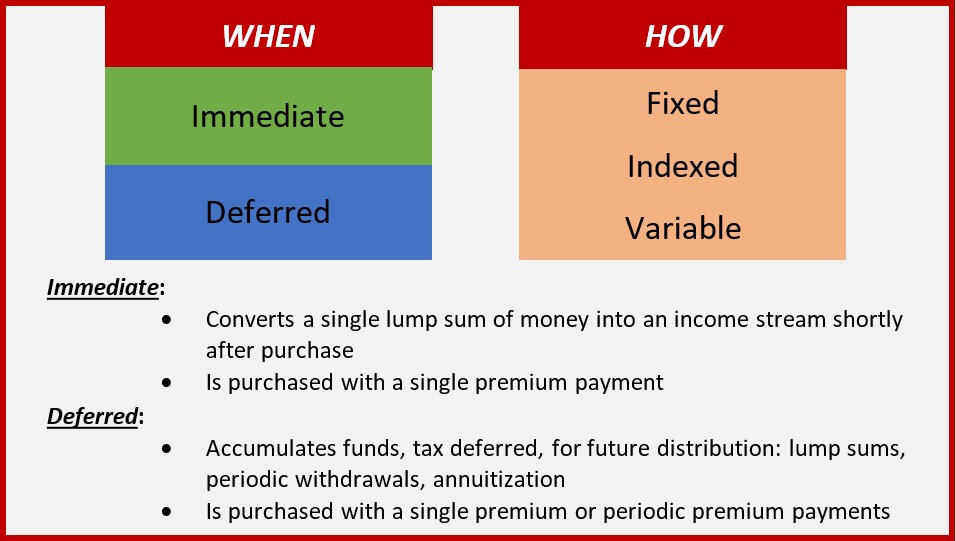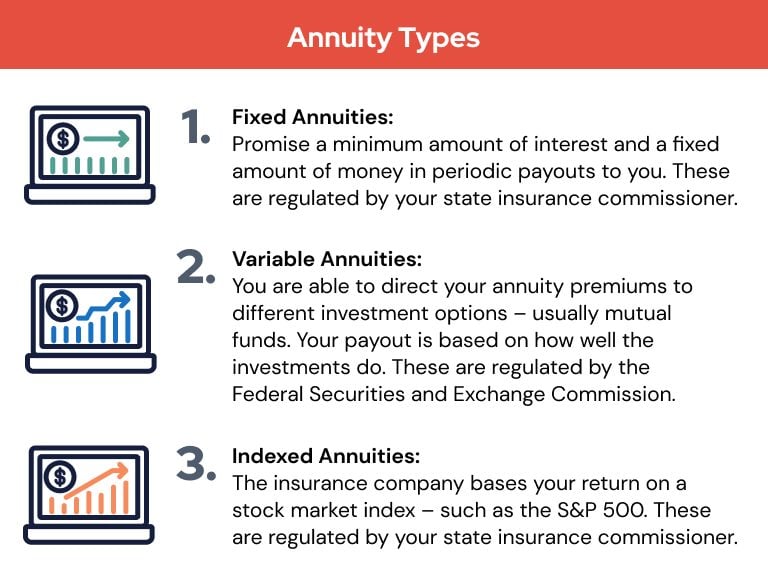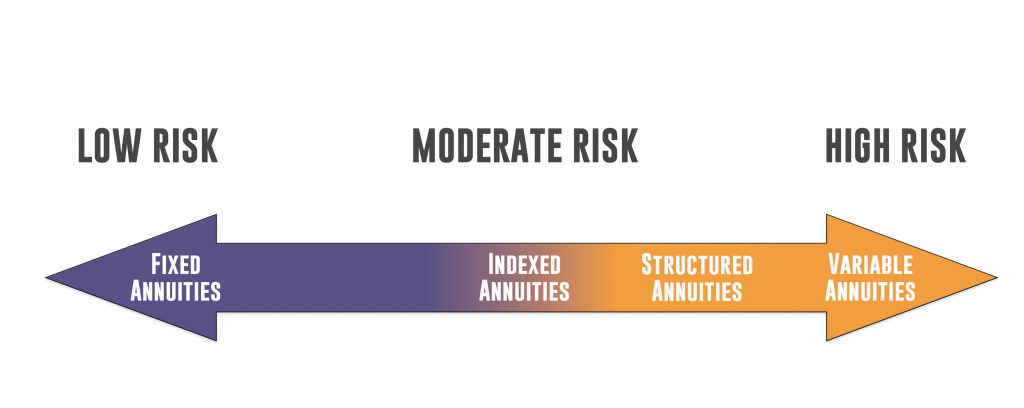All Categories
Featured
Table of Contents
Equally as with a fixed annuity, the owner of a variable annuity pays an insurance policy business a lump sum or collection of settlements for the guarantee of a series of future repayments in return. As discussed above, while a repaired annuity expands at a guaranteed, continuous price, a variable annuity grows at a variable rate that depends upon the performance of the underlying financial investments, called sub-accounts.

Throughout the accumulation phase, possessions spent in variable annuity sub-accounts expand on a tax-deferred basis and are tired just when the agreement proprietor withdraws those incomes from the account. After the buildup stage comes the earnings stage. With time, variable annuity properties need to in theory increase in value up until the agreement owner determines she or he wish to begin withdrawing cash from the account.
One of the most substantial concern that variable annuities typically present is high price. Variable annuities have numerous layers of charges and costs that can, in aggregate, develop a drag of up to 3-4% of the agreement's value every year. Below are the most common costs connected with variable annuities. This cost makes up the insurance firm for the threat that it thinks under the terms of the contract.
Breaking Down Variable Annuity Vs Fixed Annuity A Comprehensive Guide to What Is Variable Annuity Vs Fixed Annuity What Is Variable Vs Fixed Annuity? Features of Smart Investment Choices Why Choosing the Right Financial Strategy Is Worth Considering Fixed Interest Annuity Vs Variable Investment Annuity: How It Works Key Differences Between Fixed Annuity Or Variable Annuity Understanding the Key Features of Variable Annuities Vs Fixed Annuities Who Should Consider Fixed Annuity Vs Variable Annuity? Tips for Choosing Fixed Income Annuity Vs Variable Growth Annuity FAQs About Planning Your Financial Future Common Mistakes to Avoid When Planning Your Retirement Financial Planning Simplified: Understanding Your Options A Beginner’s Guide to Fixed Index Annuity Vs Variable Annuities A Closer Look at Indexed Annuity Vs Fixed Annuity
M&E cost fees are calculated as a percent of the agreement value Annuity companies hand down recordkeeping and other management expenses to the agreement proprietor. This can be in the kind of a flat annual charge or a percent of the contract value. Management costs might be consisted of as part of the M&E risk fee or might be examined separately.
These charges can vary from 0.1% for easy funds to 1.5% or more for actively taken care of funds. Annuity agreements can be personalized in a variety of means to offer the specific demands of the contract owner. Some usual variable annuity bikers consist of assured minimum accumulation advantage (GMAB), assured minimum withdrawal benefit (GMWB), and ensured minimal income advantage (GMIB).

Variable annuity payments offer no such tax obligation deduction. Variable annuities often tend to be extremely inefficient vehicles for passing wealth to the future generation due to the fact that they do not appreciate a cost-basis adjustment when the initial contract owner passes away. When the owner of a taxable investment account dies, the cost bases of the investments held in the account are gotten used to reflect the marketplace costs of those investments at the time of the owner's fatality.
Breaking Down Your Investment Choices Key Insights on Your Financial Future What Is Fixed Interest Annuity Vs Variable Investment Annuity? Features of Fixed Vs Variable Annuity Why Variable Annuities Vs Fixed Annuities Matters for Retirement Planning What Is A Variable Annuity Vs A Fixed Annuity: Explained in Detail Key Differences Between Fixed Vs Variable Annuity Understanding the Rewards of Long-Term Investments Who Should Consider Strategic Financial Planning? Tips for Choosing Fixed Income Annuity Vs Variable Annuity FAQs About Variable Annuities Vs Fixed Annuities Common Mistakes to Avoid When Choosing a Financial Strategy Financial Planning Simplified: Understanding Your Options A Beginner’s Guide to Fixed Annuity Vs Equity-linked Variable Annuity A Closer Look at How to Build a Retirement Plan
Therefore, heirs can inherit a taxed financial investment portfolio with a "fresh start" from a tax obligation point of view. Such is not the instance with variable annuities. Investments held within a variable annuity do not obtain a cost-basis change when the original proprietor of the annuity passes away. This indicates that any kind of accumulated unrealized gains will certainly be passed on to the annuity proprietor's beneficiaries, together with the connected tax problem.
One considerable issue associated with variable annuities is the potential for conflicts of rate of interest that may exist on the part of annuity salesmen. Unlike a monetary advisor, who has a fiduciary obligation to make financial investment decisions that benefit the client, an insurance broker has no such fiduciary responsibility. Annuity sales are highly financially rewarding for the insurance coverage experts that market them due to high upfront sales compensations.

Numerous variable annuity contracts include language which positions a cap on the portion of gain that can be experienced by specific sub-accounts. These caps protect against the annuity owner from fully joining a portion of gains that can otherwise be enjoyed in years in which markets create considerable returns. From an outsider's viewpoint, it would seem that capitalists are trading a cap on financial investment returns for the abovementioned assured flooring on investment returns.
As kept in mind over, surrender costs can seriously limit an annuity proprietor's ability to relocate possessions out of an annuity in the very early years of the agreement. Better, while most variable annuities allow agreement proprietors to take out a defined quantity throughout the build-up phase, withdrawals past this amount commonly cause a company-imposed fee.
Withdrawals made from a set rates of interest investment option might likewise experience a "market price change" or MVA. An MVA readjusts the value of the withdrawal to reflect any type of adjustments in rates of interest from the time that the cash was bought the fixed-rate alternative to the moment that it was taken out.

Fairly often, even the salespeople that offer them do not completely understand just how they work, and so salespeople often victimize a customer's feelings to market variable annuities rather than the benefits and suitability of the items themselves. Our team believe that investors should fully recognize what they have and just how much they are paying to possess it.
Highlighting Annuities Fixed Vs Variable Everything You Need to Know About Fixed Annuity Vs Equity-linked Variable Annuity Defining the Right Financial Strategy Features of Smart Investment Choices Why Choosing the Right Financial Strategy Matters for Retirement Planning How to Compare Different Investment Plans: Simplified Key Differences Between Fixed Annuity Vs Equity-linked Variable Annuity Understanding the Risks of Fixed Income Annuity Vs Variable Growth Annuity Who Should Consider Strategic Financial Planning? Tips for Choosing the Best Investment Strategy FAQs About Planning Your Financial Future Common Mistakes to Avoid When Choosing a Financial Strategy Financial Planning Simplified: Understanding Fixed Vs Variable Annuity A Beginner’s Guide to Smart Investment Decisions A Closer Look at How to Build a Retirement Plan
Nonetheless, the same can not be stated for variable annuity possessions kept in fixed-rate investments. These possessions lawfully come from the insurance provider and would therefore go to danger if the company were to fall short. In a similar way, any type of guarantees that the insurance provider has consented to offer, such as an ensured minimal revenue benefit, would remain in inquiry in case of an organization failure.
Prospective purchasers of variable annuities need to understand and consider the financial condition of the providing insurance coverage company prior to getting in into an annuity contract. While the benefits and disadvantages of different kinds of annuities can be debated, the genuine problem surrounding annuities is that of suitability.
As the claiming goes: "Customer beware!" This write-up is prepared by Pekin Hardy Strauss, Inc. Comparing fixed vs variable annuities. ("Pekin Hardy," dba Pekin Hardy Strauss Wide Range Administration) for informational objectives only and is not planned as a deal or solicitation for business. The information and data in this short article does not constitute lawful, tax, audit, financial investment, or various other professional suggestions
Table of Contents
Latest Posts
Exploring Pros And Cons Of Fixed Annuity And Variable Annuity A Closer Look at How Retirement Planning Works Breaking Down the Basics of Annuities Fixed Vs Variable Pros and Cons of Various Financial
Decoding How Investment Plans Work A Comprehensive Guide to Investment Choices Breaking Down the Basics of Investment Plans Features of Smart Investment Choices Why Choosing the Right Financial Strate
Exploring Variable Vs Fixed Annuities A Closer Look at How Retirement Planning Works Breaking Down the Basics of Annuity Fixed Vs Variable Advantages and Disadvantages of Fixed Indexed Annuity Vs Mark
More
Latest Posts